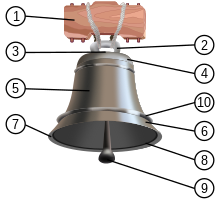ناقوس
النَاقُوس (ج. نَواقِيس) في التقاليد المسيحية هو الجرس الذي يقرع في الكنيسة لأسباب كنيسية عديدة، ويمكن سمعه خارج المبني. استعمل الناقوس تقليديًا إيذانًا بحلول وقت الصلاة أو نداء للناس بقداس جماعي. يقرع الناقوس كذلك إعلانًا لمناسبات خاصة مثل زواج أو جنازة. يستعمل أحيانًا في بعض التقاليد خلال شعائر دلالًا للمجهور على أنهم قد بلغوا جزءًا معينًا للشعيرة.[1][1] وكان يعتقد في التقاليد المسيحية أن قرع نواقيس الكنيسة يطرد العفاريت.[2][3]

ناقوس الكنيسة الأوروبي التقليدي الذي يستعمل في كنائس مسيحية حول العالم يتكون من متردد معدني على شكل كأس ذي مطرقة تتدلى داخله يضرب جوانبه الداخلية عندما يترجح الناقوس. يتعلق الناقوس داخل برج الكنيسة أو برج الجرس، لكي ينتشر صوته انتشارًا واسعًا.
الكنيسة قد يكون لها ناقوس واحد أو مجموعة من النواقيس التي تضبط على سلم موسيقي مشترك. النواقيس قد تكون ثابتة وتضرب أو معلقة وتقرع بجر حابل.
كان قرع النواقيس قبل الأزمنة المعاصرة وسيلة شائعة لتجميع الناس لكل الأغراض، دينية كانت أو غير ذلك.
التأثيل
عدلكلمة ناقوس أرامية معناها مُصوِّت مشتق من «نقش» أي ضرب وقرع ودق وهو اسم لخشبة ثم لحديدة ثم لطاس من نحاس يُقرع لأوقات الصلاة في الكنائس.[4]
مراجع
عدل- ^ ا ب Church Words: Origins and Meanings. Forward Movement. 1 أغسطس 1996. مؤرشف من الأصل في 2017-03-07. اطلع عليه بتاريخ 2012-08-16.
There are two sorts of liturgical bells in the history of the Christian Church-church bells in spires or towers used to call the faithful to worship, and sanctuary bells used to call attention to the coming of Christ in the Holy Eucharist.
- ^ Booth, Mark (11 Feb 2014). The Sacred History: How Angels, Mystics and Higher Intelligence Made Our World (بالإنجليزية). Simon and Schuster. p. 274. ISBN:9781451698589.
Church bells would be rung to drive away demons.
- ^ Cohen, I. Bernard (1990). Benjamin Franklin's Science (بالإنجليزية). Harvard University Press. p. 119. ISBN:9780674066595. Archived from the original on 2019-12-17.
The practice of ringing church bells to dissipate lightning storms and prevent their deleterious effects had a long tradition in Europe and had been a concomitant to the general belief in the diabolical agency manifested in storms. ... Typical inscriptions on church bells described their powr to "ward off lightning and malignant demons"; stated that "the sound of this bell vanquishes tempests, repels demons, and summons men," or exhorted it to "praise God, put to flight the coulds, affright the demons, and call the people"; or noted hat "it is I who dissipate the thunders."
- ^ Tobia Al-Anisi, the Lebanese Halabi، تفسير الألفاظ الدخيلة في العربية مع ذكر أصلها بحروفة، ص. 72، QID:Q117357294